Critical Analysis of the Role Played by Rail, Tram and Bus Union in NSW Worker's Dispute
VerifiedAdded on 2023/06/07
|20
|4775
|473
AI Summary
The report aims at presenting a critical analysis on the role played by the Rail, Tram and Bus Union (RTBU) in the North South Wales (NSW) worker’s dispute that took place in the year 2018. The report also draws an insight into the role of the management in maintaining employee relationships, research literature on union and the union behavior. The report also tries to give an insight into employee relationship and the role of the state in the management of employment relationship.
Contribute Materials
Your contribution can guide someone’s learning journey. Share your
documents today.
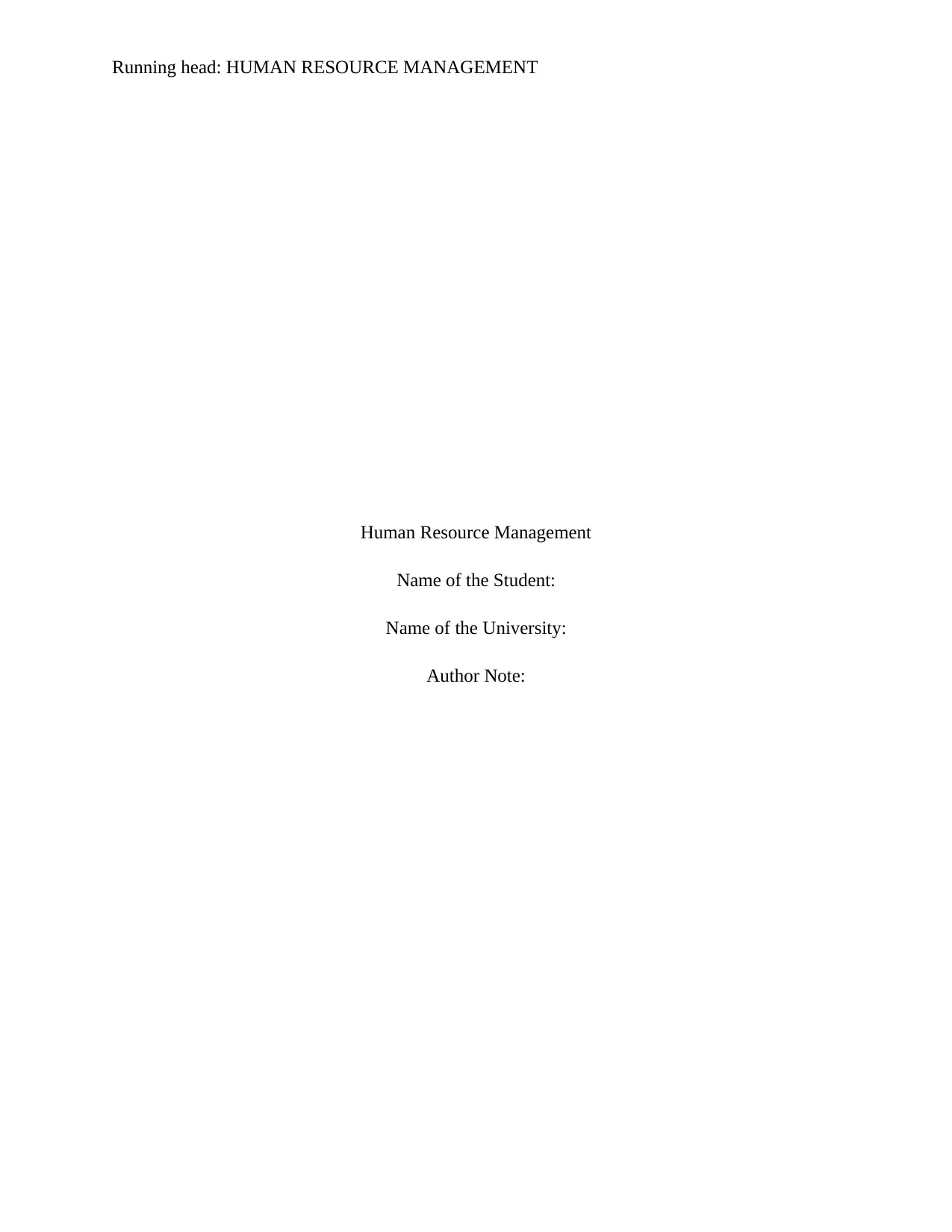
Running head: HUMAN RESOURCE MANAGEMENT
Human Resource Management
Name of the Student:
Name of the University:
Author Note:
Human Resource Management
Name of the Student:
Name of the University:
Author Note:
Secure Best Marks with AI Grader
Need help grading? Try our AI Grader for instant feedback on your assignments.

1
HUMAN RESOURCE MANAGEMENT
Table of Contents
Introduction:....................................................................................................................................2
A. Critical Analysis of the Role Played...........................................................................................2
1. Tactical Perspective Explaining the Union Behavior.................................................................2
a. Role of Unions at the Workplace and Beyond.........................................................................5
2. Justification of Perspective Based on Theories of Unions and Union Behavior.........................7
a. Theories....................................................................................................................................7
Recommendations:.......................................................................................................................9
b. Literature:.................................................................................................................................9
i. Role of Union Behaviour Based on Structures.........................................................................9
ii. Role of the Internal Governance in Defining Policy and Action of Union...........................10
B. Implications of Union Role.......................................................................................................11
1. Role of the Union in Defining its Continued Relevance in Contemporary Australian Society 11
Conclusion:....................................................................................................................................13
References:....................................................................................................................................14
Appendices:...................................................................................................................................16
HUMAN RESOURCE MANAGEMENT
Table of Contents
Introduction:....................................................................................................................................2
A. Critical Analysis of the Role Played...........................................................................................2
1. Tactical Perspective Explaining the Union Behavior.................................................................2
a. Role of Unions at the Workplace and Beyond.........................................................................5
2. Justification of Perspective Based on Theories of Unions and Union Behavior.........................7
a. Theories....................................................................................................................................7
Recommendations:.......................................................................................................................9
b. Literature:.................................................................................................................................9
i. Role of Union Behaviour Based on Structures.........................................................................9
ii. Role of the Internal Governance in Defining Policy and Action of Union...........................10
B. Implications of Union Role.......................................................................................................11
1. Role of the Union in Defining its Continued Relevance in Contemporary Australian Society 11
Conclusion:....................................................................................................................................13
References:....................................................................................................................................14
Appendices:...................................................................................................................................16

2
HUMAN RESOURCE MANAGEMENT
Introduction:
The report aims at presenting a critical analysis on the role played by the Rail, Tram and
Bus Union (RTBU) in the North South Wales (NSW) worker’s dispute that took place in the year
2018. The dispute was the result of the train workers strike after the Sydney Trains failed in
resolving the pay related dispute of the workers. Despite, the four hours of negotiations between
the RTBU and Sydney Train things did not boil down to an agreement. Although wages
remained the key point, but there was no detailed discussion on the monetary issue. Therefore,
the secretary of Rail, Tram and Bus Union (RTBU) instructed the workers to continue with the
strike until there was a full and final settlement. It was also known as industrial intrusion.
However, the RTBU played a key role in the worker’s dispute but their performance could be
determined in the tactical perspective by justifying it in reference to the relevant theory and the
employee relationship and the role of the state in the management of employment relationship.
The report also draws an insight into the role of the management in maintaining employee
relationships, research literature on union and the union behavior. The report also tries to give an
insight into employee relationship and the role of the state in the management of employment
relationship.
A. Critical Analysis of the Role Played
1. Tactical Perspective Explaining the Union Behavior
According to Cullinane, Donaghey,Dundon, Hickland & Dobbins (2014), there are different
types of employee representations. This includes the voluntary type and the state sanctioned
type. The voluntary type of employee representations included the non-union and the union. The
non-union represented consultation initiated by the management, for example, consultative
committees or company unions while union represented the collective bargaining in an informal
manner with no compulsion for the workers to recognize or bargain with them. On the other
hand, the state sanctioned type of employee representation included the statute sponsored
participation of employees for example OH&S committees and work council and the statute-
sponsored collective conciliation, arbitration and bargaining. Given the different types of
employee representation, theRail, Tram and Bus union (RTBU) is a state sanctioned employee
HUMAN RESOURCE MANAGEMENT
Introduction:
The report aims at presenting a critical analysis on the role played by the Rail, Tram and
Bus Union (RTBU) in the North South Wales (NSW) worker’s dispute that took place in the year
2018. The dispute was the result of the train workers strike after the Sydney Trains failed in
resolving the pay related dispute of the workers. Despite, the four hours of negotiations between
the RTBU and Sydney Train things did not boil down to an agreement. Although wages
remained the key point, but there was no detailed discussion on the monetary issue. Therefore,
the secretary of Rail, Tram and Bus Union (RTBU) instructed the workers to continue with the
strike until there was a full and final settlement. It was also known as industrial intrusion.
However, the RTBU played a key role in the worker’s dispute but their performance could be
determined in the tactical perspective by justifying it in reference to the relevant theory and the
employee relationship and the role of the state in the management of employment relationship.
The report also draws an insight into the role of the management in maintaining employee
relationships, research literature on union and the union behavior. The report also tries to give an
insight into employee relationship and the role of the state in the management of employment
relationship.
A. Critical Analysis of the Role Played
1. Tactical Perspective Explaining the Union Behavior
According to Cullinane, Donaghey,Dundon, Hickland & Dobbins (2014), there are different
types of employee representations. This includes the voluntary type and the state sanctioned
type. The voluntary type of employee representations included the non-union and the union. The
non-union represented consultation initiated by the management, for example, consultative
committees or company unions while union represented the collective bargaining in an informal
manner with no compulsion for the workers to recognize or bargain with them. On the other
hand, the state sanctioned type of employee representation included the statute sponsored
participation of employees for example OH&S committees and work council and the statute-
sponsored collective conciliation, arbitration and bargaining. Given the different types of
employee representation, theRail, Tram and Bus union (RTBU) is a state sanctioned employee
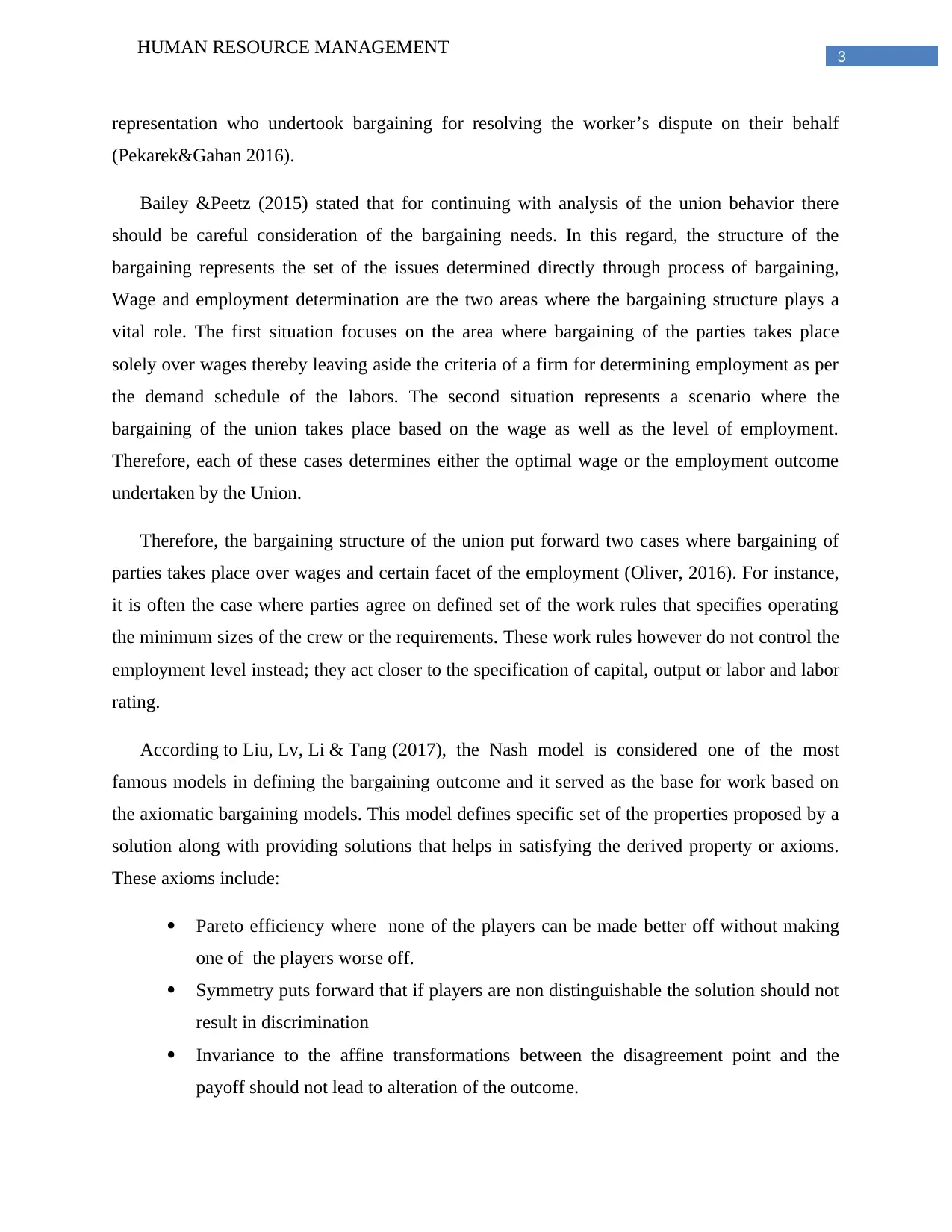
3
HUMAN RESOURCE MANAGEMENT
representation who undertook bargaining for resolving the worker’s dispute on their behalf
(Pekarek&Gahan 2016).
Bailey &Peetz (2015) stated that for continuing with analysis of the union behavior there
should be careful consideration of the bargaining needs. In this regard, the structure of the
bargaining represents the set of the issues determined directly through process of bargaining,
Wage and employment determination are the two areas where the bargaining structure plays a
vital role. The first situation focuses on the area where bargaining of the parties takes place
solely over wages thereby leaving aside the criteria of a firm for determining employment as per
the demand schedule of the labors. The second situation represents a scenario where the
bargaining of the union takes place based on the wage as well as the level of employment.
Therefore, each of these cases determines either the optimal wage or the employment outcome
undertaken by the Union.
Therefore, the bargaining structure of the union put forward two cases where bargaining of
parties takes place over wages and certain facet of the employment (Oliver, 2016). For instance,
it is often the case where parties agree on defined set of the work rules that specifies operating
the minimum sizes of the crew or the requirements. These work rules however do not control the
employment level instead; they act closer to the specification of capital, output or labor and labor
rating.
According to Liu, Lv, Li & Tang (2017), the Nash model is considered one of the most
famous models in defining the bargaining outcome and it served as the base for work based on
the axiomatic bargaining models. This model defines specific set of the properties proposed by a
solution along with providing solutions that helps in satisfying the derived property or axioms.
These axioms include:
Pareto efficiency where none of the players can be made better off without making
one of the players worse off.
Symmetry puts forward that if players are non distinguishable the solution should not
result in discrimination
Invariance to the affine transformations between the disagreement point and the
payoff should not lead to alteration of the outcome.
HUMAN RESOURCE MANAGEMENT
representation who undertook bargaining for resolving the worker’s dispute on their behalf
(Pekarek&Gahan 2016).
Bailey &Peetz (2015) stated that for continuing with analysis of the union behavior there
should be careful consideration of the bargaining needs. In this regard, the structure of the
bargaining represents the set of the issues determined directly through process of bargaining,
Wage and employment determination are the two areas where the bargaining structure plays a
vital role. The first situation focuses on the area where bargaining of the parties takes place
solely over wages thereby leaving aside the criteria of a firm for determining employment as per
the demand schedule of the labors. The second situation represents a scenario where the
bargaining of the union takes place based on the wage as well as the level of employment.
Therefore, each of these cases determines either the optimal wage or the employment outcome
undertaken by the Union.
Therefore, the bargaining structure of the union put forward two cases where bargaining of
parties takes place over wages and certain facet of the employment (Oliver, 2016). For instance,
it is often the case where parties agree on defined set of the work rules that specifies operating
the minimum sizes of the crew or the requirements. These work rules however do not control the
employment level instead; they act closer to the specification of capital, output or labor and labor
rating.
According to Liu, Lv, Li & Tang (2017), the Nash model is considered one of the most
famous models in defining the bargaining outcome and it served as the base for work based on
the axiomatic bargaining models. This model defines specific set of the properties proposed by a
solution along with providing solutions that helps in satisfying the derived property or axioms.
These axioms include:
Pareto efficiency where none of the players can be made better off without making
one of the players worse off.
Symmetry puts forward that if players are non distinguishable the solution should not
result in discrimination
Invariance to the affine transformations between the disagreement point and the
payoff should not lead to alteration of the outcome.
Paraphrase This Document
Need a fresh take? Get an instant paraphrase of this document with our AI Paraphraser
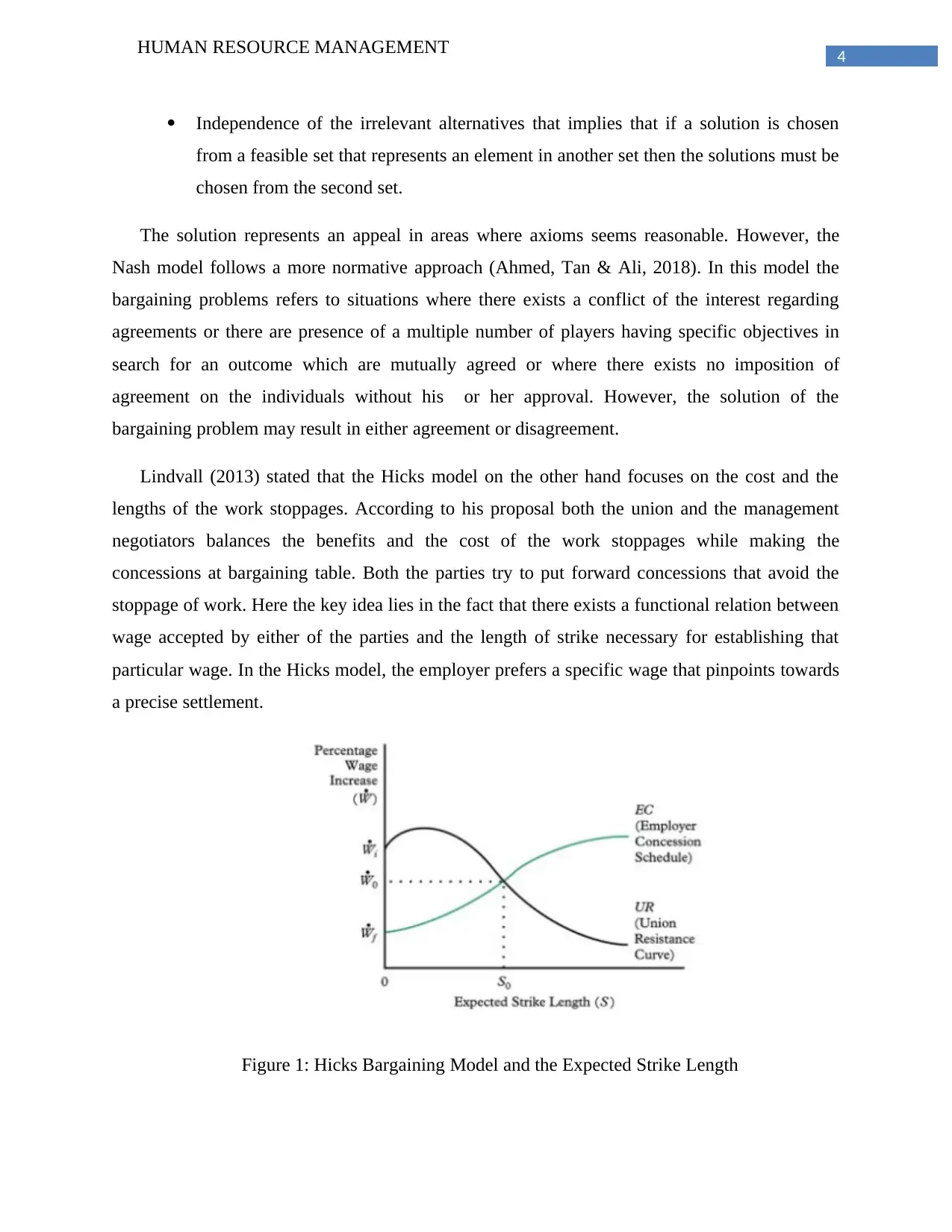
4
HUMAN RESOURCE MANAGEMENT
Independence of the irrelevant alternatives that implies that if a solution is chosen
from a feasible set that represents an element in another set then the solutions must be
chosen from the second set.
The solution represents an appeal in areas where axioms seems reasonable. However, the
Nash model follows a more normative approach (Ahmed, Tan & Ali, 2018). In this model the
bargaining problems refers to situations where there exists a conflict of the interest regarding
agreements or there are presence of a multiple number of players having specific objectives in
search for an outcome which are mutually agreed or where there exists no imposition of
agreement on the individuals without his or her approval. However, the solution of the
bargaining problem may result in either agreement or disagreement.
Lindvall (2013) stated that the Hicks model on the other hand focuses on the cost and the
lengths of the work stoppages. According to his proposal both the union and the management
negotiators balances the benefits and the cost of the work stoppages while making the
concessions at bargaining table. Both the parties try to put forward concessions that avoid the
stoppage of work. Here the key idea lies in the fact that there exists a functional relation between
wage accepted by either of the parties and the length of strike necessary for establishing that
particular wage. In the Hicks model, the employer prefers a specific wage that pinpoints towards
a precise settlement.
Figure 1: Hicks Bargaining Model and the Expected Strike Length
HUMAN RESOURCE MANAGEMENT
Independence of the irrelevant alternatives that implies that if a solution is chosen
from a feasible set that represents an element in another set then the solutions must be
chosen from the second set.
The solution represents an appeal in areas where axioms seems reasonable. However, the
Nash model follows a more normative approach (Ahmed, Tan & Ali, 2018). In this model the
bargaining problems refers to situations where there exists a conflict of the interest regarding
agreements or there are presence of a multiple number of players having specific objectives in
search for an outcome which are mutually agreed or where there exists no imposition of
agreement on the individuals without his or her approval. However, the solution of the
bargaining problem may result in either agreement or disagreement.
Lindvall (2013) stated that the Hicks model on the other hand focuses on the cost and the
lengths of the work stoppages. According to his proposal both the union and the management
negotiators balances the benefits and the cost of the work stoppages while making the
concessions at bargaining table. Both the parties try to put forward concessions that avoid the
stoppage of work. Here the key idea lies in the fact that there exists a functional relation between
wage accepted by either of the parties and the length of strike necessary for establishing that
particular wage. In the Hicks model, the employer prefers a specific wage that pinpoints towards
a precise settlement.
Figure 1: Hicks Bargaining Model and the Expected Strike Length

5
HUMAN RESOURCE MANAGEMENT
Source: (Atherton, 2015)
From the above figure, it is evident that the Hicks model presents an upward sloping
employer concession schedule and downward inclined resistance curve of the employer. The
concession schedule represents the process that leads to the agreement instead of the specific
behavioral underpinnings that leads to the popularity of the model. The resistance curve on the
other hand represents the time length that the workers are willing in standing out instead of
allowing the remuneration in falling below the corresponding wages. The downward sloping
nature of the curve represents the sacrifice of the workers in accepting the lower wages is higher
such that they will be willing in endure longer strike for avoiding such a situation. Hicks
however redefined the concession schedule in a precise manner by stating that the sequence of
the wage strike pair remains in balance. The graph also puts forward an upward sloping curve
due to higher cost of concession at a higher wage and the increase in the cost due to the longer
strikes. Thus, the concession schedule of the employer depends on the equality of the total costs
instead of marginal considerations that signifies an optimizing model. It seems quite natural, that
the interpretation between the intersection between the resistance curve and concession curve as
the outcome of the bargaining
a. Role of Unions at the Workplace and Beyond
Oka (2016) put forward, that union represented a mechanism through which employees
contributes to the enforcement and the authorship of the rules that helps in regulating
employment relationship. In other words, union also represented means through which the
employees are able to influence the terms and the conditions, practices and processes of the
workplace. Unions at work might have either a monopoly face or an institutional response or
collective voice response face. Through the monopoly face, the unions ensures uniting the
individual employees in groups in order to seek a hike in wages while improving the conditions
of the employment beyond rates as would be expected under the pure market. The collective
voice or the institutional response face of the unions assists the employers in communicating the
concern of the employers regarding the conditions of employment thereby helping the employers
in finding a remedy to the problems.
HUMAN RESOURCE MANAGEMENT
Source: (Atherton, 2015)
From the above figure, it is evident that the Hicks model presents an upward sloping
employer concession schedule and downward inclined resistance curve of the employer. The
concession schedule represents the process that leads to the agreement instead of the specific
behavioral underpinnings that leads to the popularity of the model. The resistance curve on the
other hand represents the time length that the workers are willing in standing out instead of
allowing the remuneration in falling below the corresponding wages. The downward sloping
nature of the curve represents the sacrifice of the workers in accepting the lower wages is higher
such that they will be willing in endure longer strike for avoiding such a situation. Hicks
however redefined the concession schedule in a precise manner by stating that the sequence of
the wage strike pair remains in balance. The graph also puts forward an upward sloping curve
due to higher cost of concession at a higher wage and the increase in the cost due to the longer
strikes. Thus, the concession schedule of the employer depends on the equality of the total costs
instead of marginal considerations that signifies an optimizing model. It seems quite natural, that
the interpretation between the intersection between the resistance curve and concession curve as
the outcome of the bargaining
a. Role of Unions at the Workplace and Beyond
Oka (2016) put forward, that union represented a mechanism through which employees
contributes to the enforcement and the authorship of the rules that helps in regulating
employment relationship. In other words, union also represented means through which the
employees are able to influence the terms and the conditions, practices and processes of the
workplace. Unions at work might have either a monopoly face or an institutional response or
collective voice response face. Through the monopoly face, the unions ensures uniting the
individual employees in groups in order to seek a hike in wages while improving the conditions
of the employment beyond rates as would be expected under the pure market. The collective
voice or the institutional response face of the unions assists the employers in communicating the
concern of the employers regarding the conditions of employment thereby helping the employers
in finding a remedy to the problems.
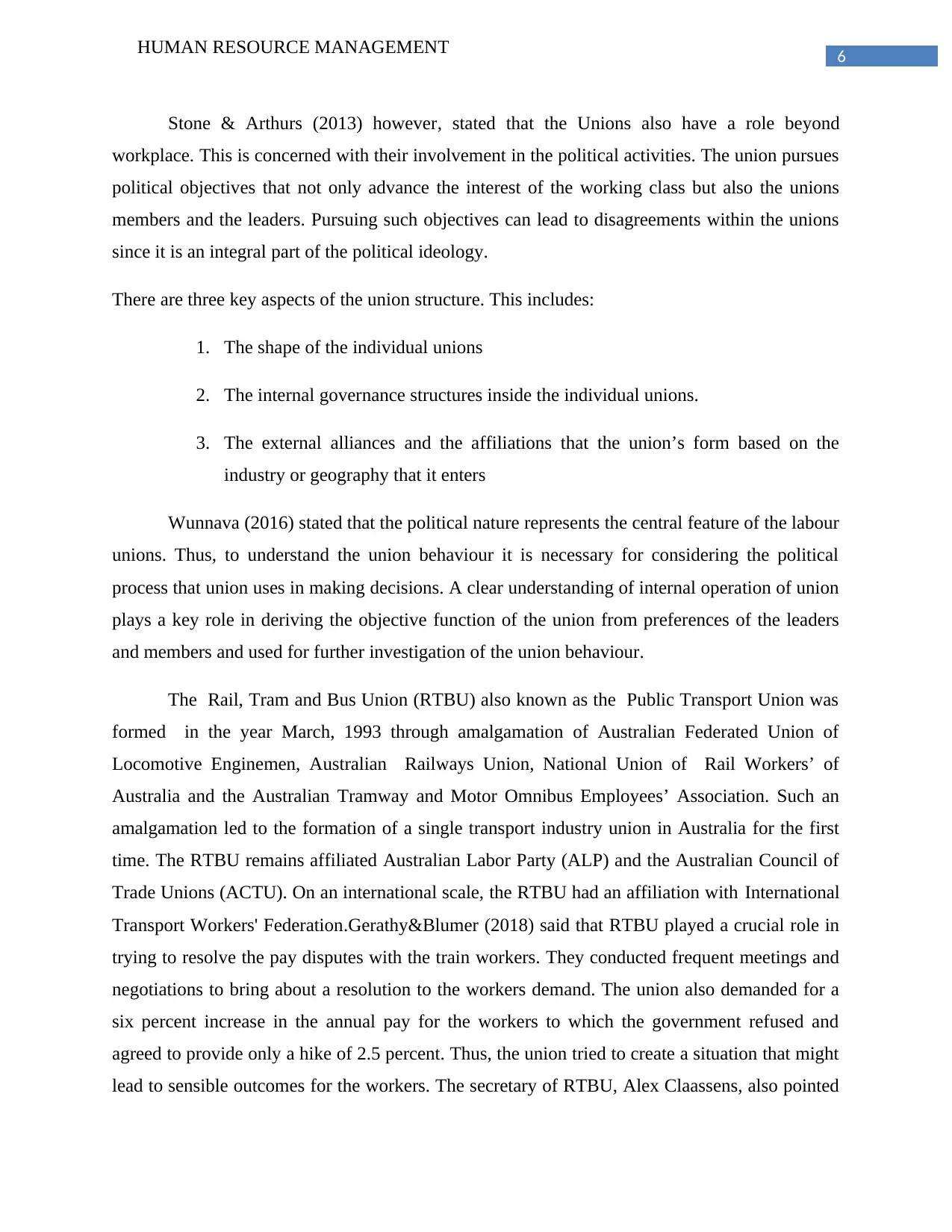
6
HUMAN RESOURCE MANAGEMENT
Stone & Arthurs (2013) however, stated that the Unions also have a role beyond
workplace. This is concerned with their involvement in the political activities. The union pursues
political objectives that not only advance the interest of the working class but also the unions
members and the leaders. Pursuing such objectives can lead to disagreements within the unions
since it is an integral part of the political ideology.
There are three key aspects of the union structure. This includes:
1. The shape of the individual unions
2. The internal governance structures inside the individual unions.
3. The external alliances and the affiliations that the union’s form based on the
industry or geography that it enters
Wunnava (2016) stated that the political nature represents the central feature of the labour
unions. Thus, to understand the union behaviour it is necessary for considering the political
process that union uses in making decisions. A clear understanding of internal operation of union
plays a key role in deriving the objective function of the union from preferences of the leaders
and members and used for further investigation of the union behaviour.
The Rail, Tram and Bus Union (RTBU) also known as the Public Transport Union was
formed in the year March, 1993 through amalgamation of Australian Federated Union of
Locomotive Enginemen, Australian Railways Union, National Union of Rail Workers’ of
Australia and the Australian Tramway and Motor Omnibus Employees’ Association. Such an
amalgamation led to the formation of a single transport industry union in Australia for the first
time. The RTBU remains affiliated Australian Labor Party (ALP) and the Australian Council of
Trade Unions (ACTU). On an international scale, the RTBU had an affiliation with International
Transport Workers' Federation.Gerathy&Blumer (2018) said that RTBU played a crucial role in
trying to resolve the pay disputes with the train workers. They conducted frequent meetings and
negotiations to bring about a resolution to the workers demand. The union also demanded for a
six percent increase in the annual pay for the workers to which the government refused and
agreed to provide only a hike of 2.5 percent. Thus, the union tried to create a situation that might
lead to sensible outcomes for the workers. The secretary of RTBU, Alex Claassens, also pointed
HUMAN RESOURCE MANAGEMENT
Stone & Arthurs (2013) however, stated that the Unions also have a role beyond
workplace. This is concerned with their involvement in the political activities. The union pursues
political objectives that not only advance the interest of the working class but also the unions
members and the leaders. Pursuing such objectives can lead to disagreements within the unions
since it is an integral part of the political ideology.
There are three key aspects of the union structure. This includes:
1. The shape of the individual unions
2. The internal governance structures inside the individual unions.
3. The external alliances and the affiliations that the union’s form based on the
industry or geography that it enters
Wunnava (2016) stated that the political nature represents the central feature of the labour
unions. Thus, to understand the union behaviour it is necessary for considering the political
process that union uses in making decisions. A clear understanding of internal operation of union
plays a key role in deriving the objective function of the union from preferences of the leaders
and members and used for further investigation of the union behaviour.
The Rail, Tram and Bus Union (RTBU) also known as the Public Transport Union was
formed in the year March, 1993 through amalgamation of Australian Federated Union of
Locomotive Enginemen, Australian Railways Union, National Union of Rail Workers’ of
Australia and the Australian Tramway and Motor Omnibus Employees’ Association. Such an
amalgamation led to the formation of a single transport industry union in Australia for the first
time. The RTBU remains affiliated Australian Labor Party (ALP) and the Australian Council of
Trade Unions (ACTU). On an international scale, the RTBU had an affiliation with International
Transport Workers' Federation.Gerathy&Blumer (2018) said that RTBU played a crucial role in
trying to resolve the pay disputes with the train workers. They conducted frequent meetings and
negotiations to bring about a resolution to the workers demand. The union also demanded for a
six percent increase in the annual pay for the workers to which the government refused and
agreed to provide only a hike of 2.5 percent. Thus, the union tried to create a situation that might
lead to sensible outcomes for the workers. The secretary of RTBU, Alex Claassens, also pointed
Secure Best Marks with AI Grader
Need help grading? Try our AI Grader for instant feedback on your assignments.

7
HUMAN RESOURCE MANAGEMENT
out that rostering has been one of the key points and the workers remained too thinly spread
especially during the rollout of the newer timetable. The union secretary also insisted on a
reliable and safe railway where the workers remain compensated for the job.
From the tactical perspective, it can be said that the unions played an effective role in
following up with extreme demands on behalf of the workers, following commitment tactics and
accepting a negotiation strategy. However, in addition to forcing an upward wage rate on behalf
of non-union members they could have also enforced Sydney trains for employing few more
workers and get themselves involved in various other political activities. The Rail, Tram and Bus
union (RTBU) represented a monopoly face in supporting the NSW train worker’s dispute
regarding the price hike.
2. Justification of Perspective Based on Theories of Unions and Union Behavior
a. Theories
According to Bray, Waring, Cooper &Macneil, J. (2014), there are three distinct
standpoint of employment relationship. Thisincludes:
Theory of Unitarism: According to this theory, the employment relationship between
the employees and the employers are harmonious since they share a common interest within the
organizational goals (Cullinane&Dundon, 2014). The unions here act as external third parties
that not only disrupt relationships but also compete with the managTement for the commitment
and the loyalty of the employees.
Concerning NSW train workers dispute, the government followed a unitarist approach in
satisfying the RTBU and the NSW train workers by agreeing to 3 percent pay hike. The
government also assisted the employees and the employers in resolving the dispute(Kontominas,
2018).
Theory of Pluralism: According to this theory, the employment relationship has a
potential for conflict due to the difference in the interest of the employees and the employers
(Greenwood & Van Buren, 2017). These conflicts are legitimate and accommodated by the
suitable network of substantive and procedural rules. According to this perspective, the role of
HUMAN RESOURCE MANAGEMENT
out that rostering has been one of the key points and the workers remained too thinly spread
especially during the rollout of the newer timetable. The union secretary also insisted on a
reliable and safe railway where the workers remain compensated for the job.
From the tactical perspective, it can be said that the unions played an effective role in
following up with extreme demands on behalf of the workers, following commitment tactics and
accepting a negotiation strategy. However, in addition to forcing an upward wage rate on behalf
of non-union members they could have also enforced Sydney trains for employing few more
workers and get themselves involved in various other political activities. The Rail, Tram and Bus
union (RTBU) represented a monopoly face in supporting the NSW train worker’s dispute
regarding the price hike.
2. Justification of Perspective Based on Theories of Unions and Union Behavior
a. Theories
According to Bray, Waring, Cooper &Macneil, J. (2014), there are three distinct
standpoint of employment relationship. Thisincludes:
Theory of Unitarism: According to this theory, the employment relationship between
the employees and the employers are harmonious since they share a common interest within the
organizational goals (Cullinane&Dundon, 2014). The unions here act as external third parties
that not only disrupt relationships but also compete with the managTement for the commitment
and the loyalty of the employees.
Concerning NSW train workers dispute, the government followed a unitarist approach in
satisfying the RTBU and the NSW train workers by agreeing to 3 percent pay hike. The
government also assisted the employees and the employers in resolving the dispute(Kontominas,
2018).
Theory of Pluralism: According to this theory, the employment relationship has a
potential for conflict due to the difference in the interest of the employees and the employers
(Greenwood & Van Buren, 2017). These conflicts are legitimate and accommodated by the
suitable network of substantive and procedural rules. According to this perspective, the role of
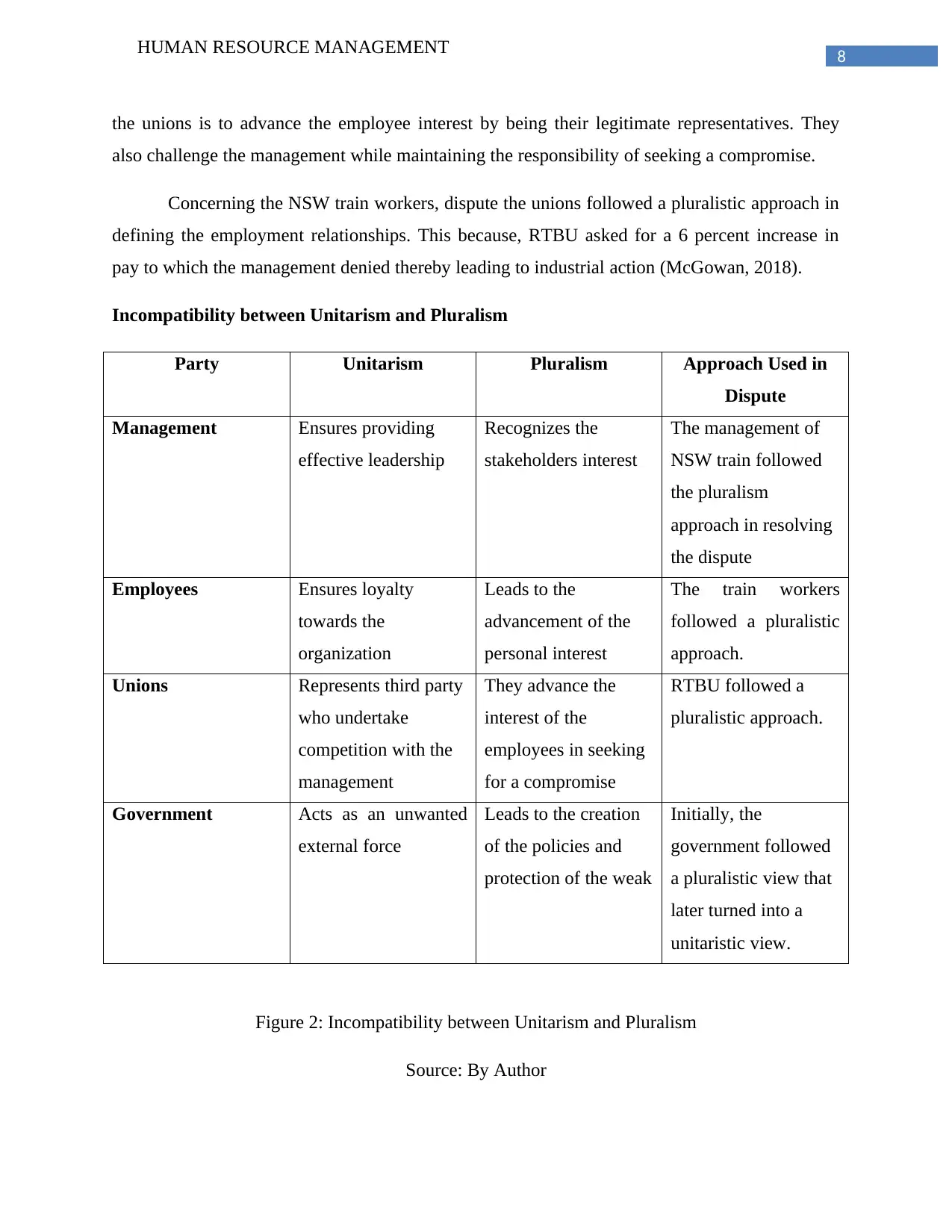
8
HUMAN RESOURCE MANAGEMENT
the unions is to advance the employee interest by being their legitimate representatives. They
also challenge the management while maintaining the responsibility of seeking a compromise.
Concerning the NSW train workers, dispute the unions followed a pluralistic approach in
defining the employment relationships. This because, RTBU asked for a 6 percent increase in
pay to which the management denied thereby leading to industrial action (McGowan, 2018).
Incompatibility between Unitarism and Pluralism
Party Unitarism Pluralism Approach Used in
Dispute
Management Ensures providing
effective leadership
Recognizes the
stakeholders interest
The management of
NSW train followed
the pluralism
approach in resolving
the dispute
Employees Ensures loyalty
towards the
organization
Leads to the
advancement of the
personal interest
The train workers
followed a pluralistic
approach.
Unions Represents third party
who undertake
competition with the
management
They advance the
interest of the
employees in seeking
for a compromise
RTBU followed a
pluralistic approach.
Government Acts as an unwanted
external force
Leads to the creation
of the policies and
protection of the weak
Initially, the
government followed
a pluralistic view that
later turned into a
unitaristic view.
Figure 2: Incompatibility between Unitarism and Pluralism
Source: By Author
HUMAN RESOURCE MANAGEMENT
the unions is to advance the employee interest by being their legitimate representatives. They
also challenge the management while maintaining the responsibility of seeking a compromise.
Concerning the NSW train workers, dispute the unions followed a pluralistic approach in
defining the employment relationships. This because, RTBU asked for a 6 percent increase in
pay to which the management denied thereby leading to industrial action (McGowan, 2018).
Incompatibility between Unitarism and Pluralism
Party Unitarism Pluralism Approach Used in
Dispute
Management Ensures providing
effective leadership
Recognizes the
stakeholders interest
The management of
NSW train followed
the pluralism
approach in resolving
the dispute
Employees Ensures loyalty
towards the
organization
Leads to the
advancement of the
personal interest
The train workers
followed a pluralistic
approach.
Unions Represents third party
who undertake
competition with the
management
They advance the
interest of the
employees in seeking
for a compromise
RTBU followed a
pluralistic approach.
Government Acts as an unwanted
external force
Leads to the creation
of the policies and
protection of the weak
Initially, the
government followed
a pluralistic view that
later turned into a
unitaristic view.
Figure 2: Incompatibility between Unitarism and Pluralism
Source: By Author
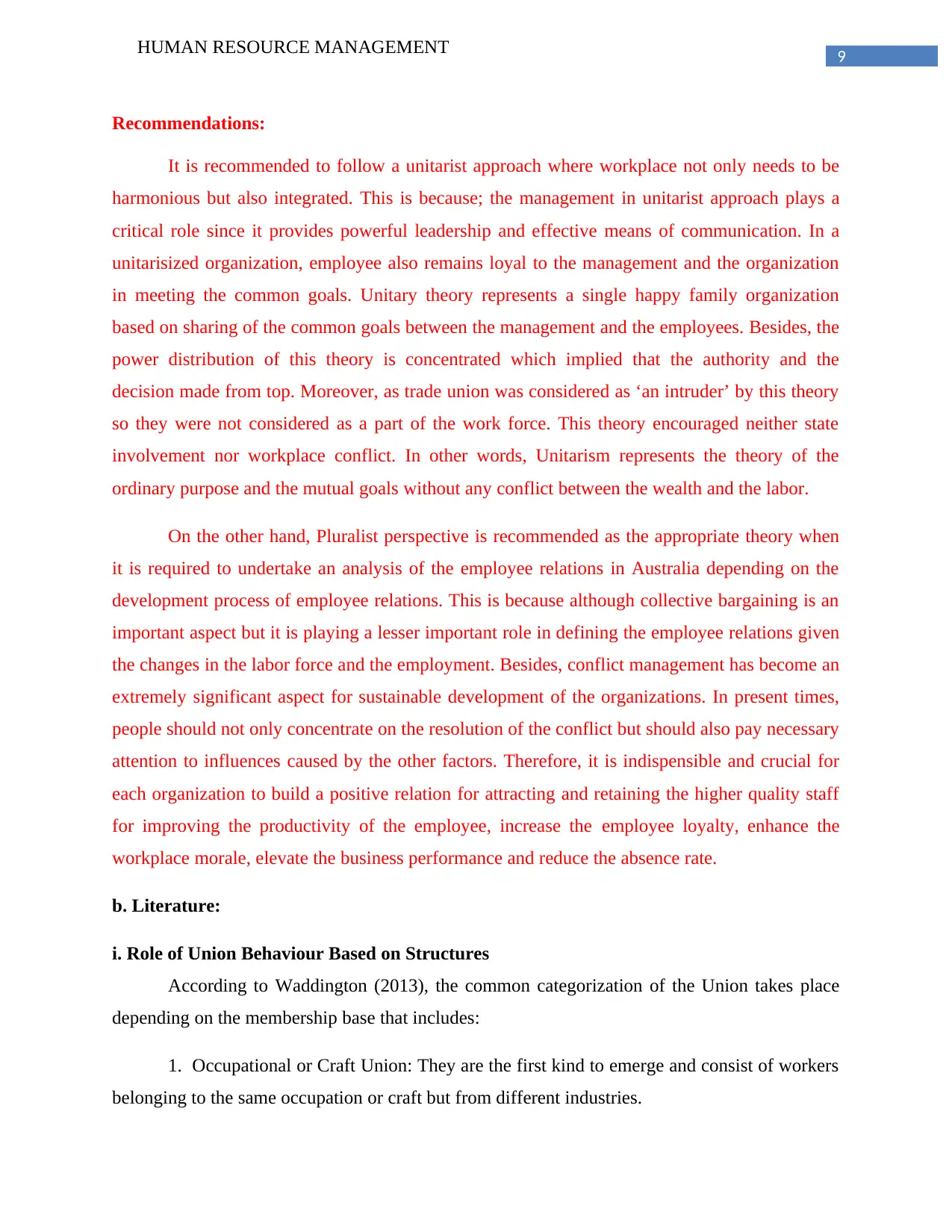
9
HUMAN RESOURCE MANAGEMENT
Recommendations:
It is recommended to follow a unitarist approach where workplace not only needs to be
harmonious but also integrated. This is because; the management in unitarist approach plays a
critical role since it provides powerful leadership and effective means of communication. In a
unitarisized organization, employee also remains loyal to the management and the organization
in meeting the common goals. Unitary theory represents a single happy family organization
based on sharing of the common goals between the management and the employees. Besides, the
power distribution of this theory is concentrated which implied that the authority and the
decision made from top. Moreover, as trade union was considered as ‘an intruder’ by this theory
so they were not considered as a part of the work force. This theory encouraged neither state
involvement nor workplace conflict. In other words, Unitarism represents the theory of the
ordinary purpose and the mutual goals without any conflict between the wealth and the labor.
On the other hand, Pluralist perspective is recommended as the appropriate theory when
it is required to undertake an analysis of the employee relations in Australia depending on the
development process of employee relations. This is because although collective bargaining is an
important aspect but it is playing a lesser important role in defining the employee relations given
the changes in the labor force and the employment. Besides, conflict management has become an
extremely significant aspect for sustainable development of the organizations. In present times,
people should not only concentrate on the resolution of the conflict but should also pay necessary
attention to influences caused by the other factors. Therefore, it is indispensible and crucial for
each organization to build a positive relation for attracting and retaining the higher quality staff
for improving the productivity of the employee, increase the employee loyalty, enhance the
workplace morale, elevate the business performance and reduce the absence rate.
b. Literature:
i. Role of Union Behaviour Based on Structures
According to Waddington (2013), the common categorization of the Union takes place
depending on the membership base that includes:
1. Occupational or Craft Union: They are the first kind to emerge and consist of workers
belonging to the same occupation or craft but from different industries.
HUMAN RESOURCE MANAGEMENT
Recommendations:
It is recommended to follow a unitarist approach where workplace not only needs to be
harmonious but also integrated. This is because; the management in unitarist approach plays a
critical role since it provides powerful leadership and effective means of communication. In a
unitarisized organization, employee also remains loyal to the management and the organization
in meeting the common goals. Unitary theory represents a single happy family organization
based on sharing of the common goals between the management and the employees. Besides, the
power distribution of this theory is concentrated which implied that the authority and the
decision made from top. Moreover, as trade union was considered as ‘an intruder’ by this theory
so they were not considered as a part of the work force. This theory encouraged neither state
involvement nor workplace conflict. In other words, Unitarism represents the theory of the
ordinary purpose and the mutual goals without any conflict between the wealth and the labor.
On the other hand, Pluralist perspective is recommended as the appropriate theory when
it is required to undertake an analysis of the employee relations in Australia depending on the
development process of employee relations. This is because although collective bargaining is an
important aspect but it is playing a lesser important role in defining the employee relations given
the changes in the labor force and the employment. Besides, conflict management has become an
extremely significant aspect for sustainable development of the organizations. In present times,
people should not only concentrate on the resolution of the conflict but should also pay necessary
attention to influences caused by the other factors. Therefore, it is indispensible and crucial for
each organization to build a positive relation for attracting and retaining the higher quality staff
for improving the productivity of the employee, increase the employee loyalty, enhance the
workplace morale, elevate the business performance and reduce the absence rate.
b. Literature:
i. Role of Union Behaviour Based on Structures
According to Waddington (2013), the common categorization of the Union takes place
depending on the membership base that includes:
1. Occupational or Craft Union: They are the first kind to emerge and consist of workers
belonging to the same occupation or craft but from different industries.
Paraphrase This Document
Need a fresh take? Get an instant paraphrase of this document with our AI Paraphraser
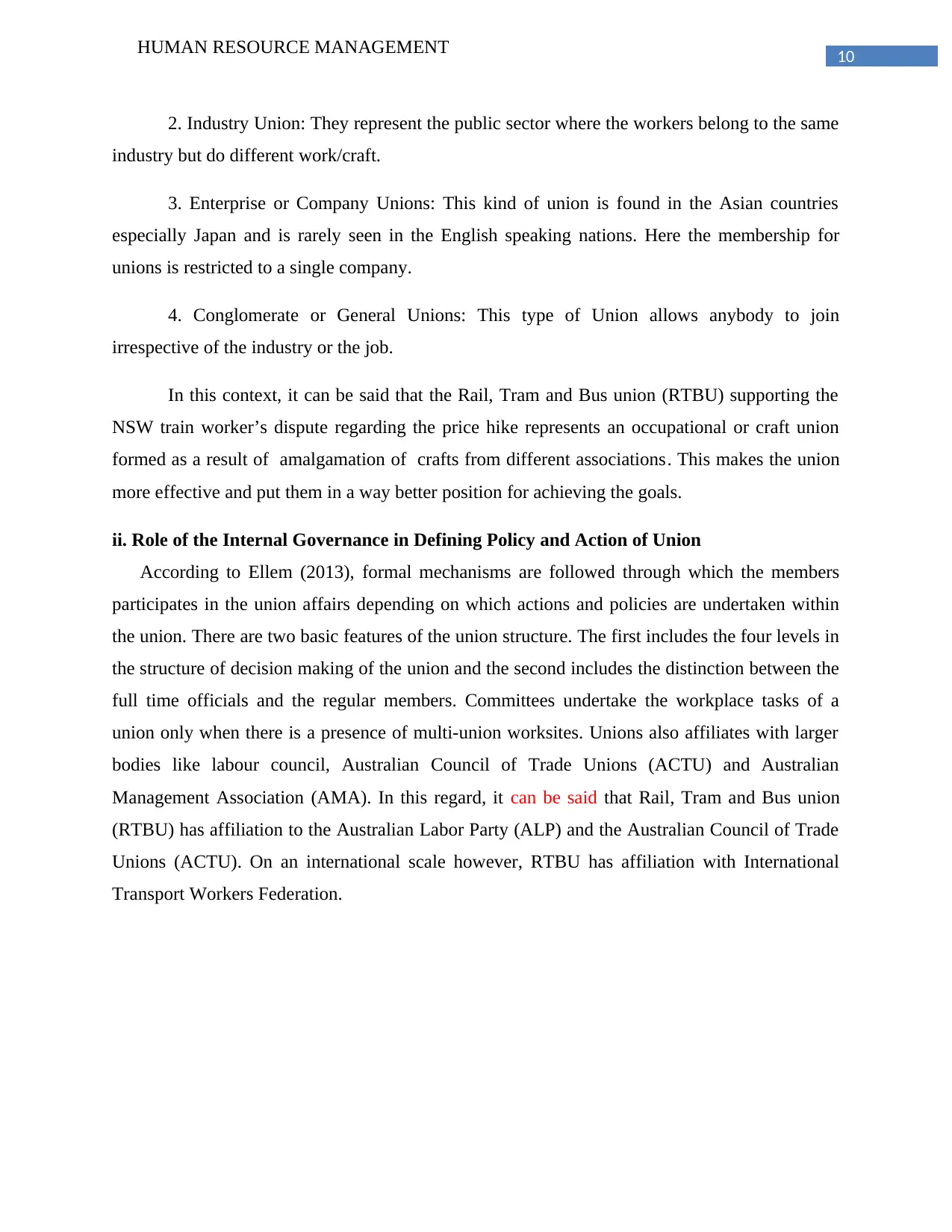
10
HUMAN RESOURCE MANAGEMENT
2. Industry Union: They represent the public sector where the workers belong to the same
industry but do different work/craft.
3. Enterprise or Company Unions: This kind of union is found in the Asian countries
especially Japan and is rarely seen in the English speaking nations. Here the membership for
unions is restricted to a single company.
4. Conglomerate or General Unions: This type of Union allows anybody to join
irrespective of the industry or the job.
In this context, it can be said that the Rail, Tram and Bus union (RTBU) supporting the
NSW train worker’s dispute regarding the price hike represents an occupational or craft union
formed as a result of amalgamation of crafts from different associations. This makes the union
more effective and put them in a way better position for achieving the goals.
ii. Role of the Internal Governance in Defining Policy and Action of Union
According to Ellem (2013), formal mechanisms are followed through which the members
participates in the union affairs depending on which actions and policies are undertaken within
the union. There are two basic features of the union structure. The first includes the four levels in
the structure of decision making of the union and the second includes the distinction between the
full time officials and the regular members. Committees undertake the workplace tasks of a
union only when there is a presence of multi-union worksites. Unions also affiliates with larger
bodies like labour council, Australian Council of Trade Unions (ACTU) and Australian
Management Association (AMA). In this regard, it can be said that Rail, Tram and Bus union
(RTBU) has affiliation to the Australian Labor Party (ALP) and the Australian Council of Trade
Unions (ACTU). On an international scale however, RTBU has affiliation with International
Transport Workers Federation.
HUMAN RESOURCE MANAGEMENT
2. Industry Union: They represent the public sector where the workers belong to the same
industry but do different work/craft.
3. Enterprise or Company Unions: This kind of union is found in the Asian countries
especially Japan and is rarely seen in the English speaking nations. Here the membership for
unions is restricted to a single company.
4. Conglomerate or General Unions: This type of Union allows anybody to join
irrespective of the industry or the job.
In this context, it can be said that the Rail, Tram and Bus union (RTBU) supporting the
NSW train worker’s dispute regarding the price hike represents an occupational or craft union
formed as a result of amalgamation of crafts from different associations. This makes the union
more effective and put them in a way better position for achieving the goals.
ii. Role of the Internal Governance in Defining Policy and Action of Union
According to Ellem (2013), formal mechanisms are followed through which the members
participates in the union affairs depending on which actions and policies are undertaken within
the union. There are two basic features of the union structure. The first includes the four levels in
the structure of decision making of the union and the second includes the distinction between the
full time officials and the regular members. Committees undertake the workplace tasks of a
union only when there is a presence of multi-union worksites. Unions also affiliates with larger
bodies like labour council, Australian Council of Trade Unions (ACTU) and Australian
Management Association (AMA). In this regard, it can be said that Rail, Tram and Bus union
(RTBU) has affiliation to the Australian Labor Party (ALP) and the Australian Council of Trade
Unions (ACTU). On an international scale however, RTBU has affiliation with International
Transport Workers Federation.

11
HUMAN RESOURCE MANAGEMENT
B. Implications of Union Role
1. Role of the Union in Defining its Continued Relevance in Contemporary Australian
Society
Unions have been a part of Australia for over 150 years. During the period 1800 to 1890,
unions emerged in the societies formed by the skilled artisans especially in the maritime, mining
and the pastoral sectors. Unions however had a strong position in the Australian society by end
of 1880s but strikes and depression between the 1890 and 1894 destroyed the trade unions and
encouraged the formation of the Australian Labor Party (ALP) (Bray, Waring, Cooper &
Macneil, 2014). The period between 1900 and1989 saw the introduction of the conciliation and
arbitration act and the emergence of the Australian Council of Trade Unions (ACTU) and its
state branches. However, according to McGowan (2018), the period between 2007 and 2013 saw
lower union activity followed by its decline. The decline primarily caused due to the changing
perceptions of the public, changing structure of the employment, anti-union activities of the
management, government policies and the failure and inactivity of the unions in maintaining
effective networks at workplace.
HUMAN RESOURCE MANAGEMENT
B. Implications of Union Role
1. Role of the Union in Defining its Continued Relevance in Contemporary Australian
Society
Unions have been a part of Australia for over 150 years. During the period 1800 to 1890,
unions emerged in the societies formed by the skilled artisans especially in the maritime, mining
and the pastoral sectors. Unions however had a strong position in the Australian society by end
of 1880s but strikes and depression between the 1890 and 1894 destroyed the trade unions and
encouraged the formation of the Australian Labor Party (ALP) (Bray, Waring, Cooper &
Macneil, 2014). The period between 1900 and1989 saw the introduction of the conciliation and
arbitration act and the emergence of the Australian Council of Trade Unions (ACTU) and its
state branches. However, according to McGowan (2018), the period between 2007 and 2013 saw
lower union activity followed by its decline. The decline primarily caused due to the changing
perceptions of the public, changing structure of the employment, anti-union activities of the
management, government policies and the failure and inactivity of the unions in maintaining
effective networks at workplace.
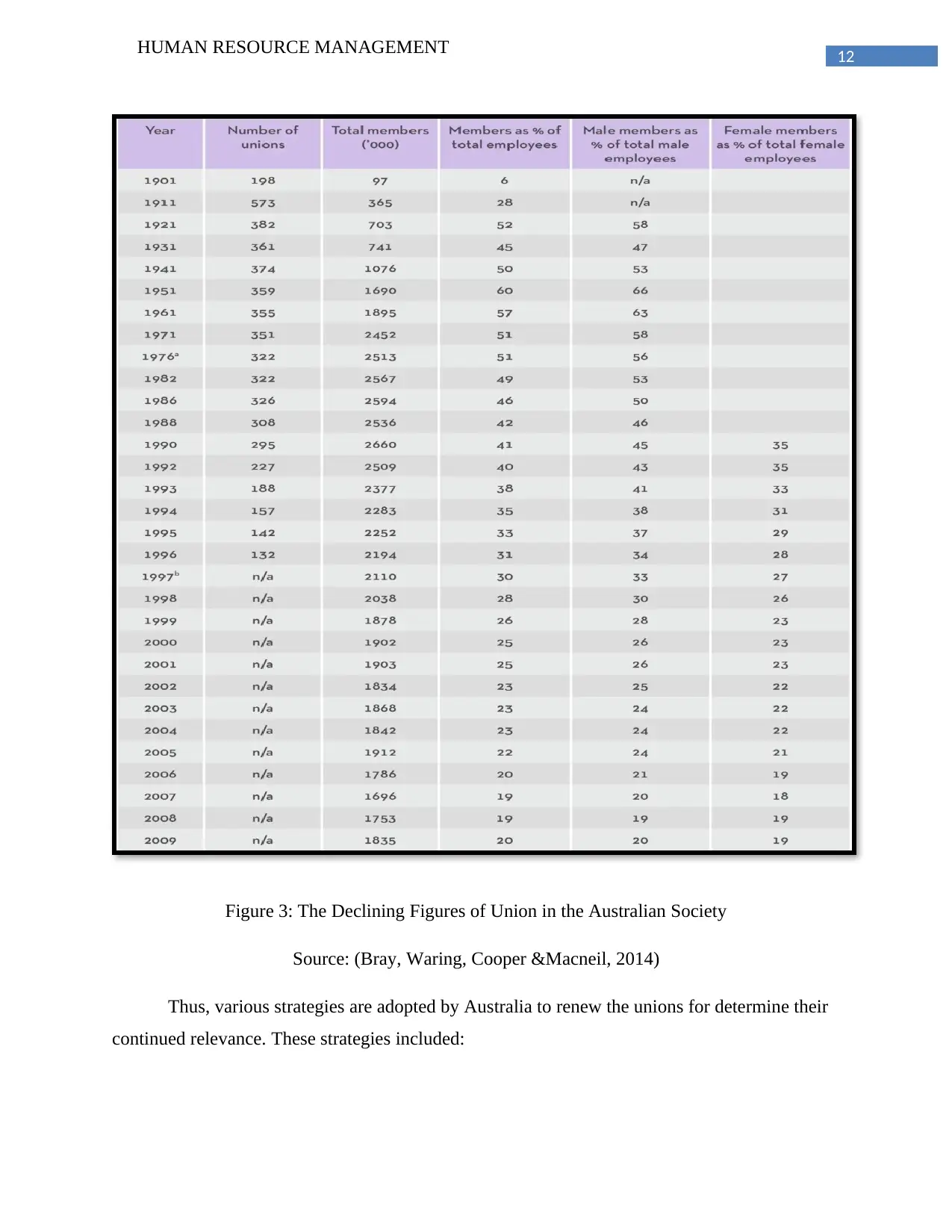
12
HUMAN RESOURCE MANAGEMENT
Figure 3: The Declining Figures of Union in the Australian Society
Source: (Bray, Waring, Cooper &Macneil, 2014)
Thus, various strategies are adopted by Australia to renew the unions for determine their
continued relevance. These strategies included:
HUMAN RESOURCE MANAGEMENT
Figure 3: The Declining Figures of Union in the Australian Society
Source: (Bray, Waring, Cooper &Macneil, 2014)
Thus, various strategies are adopted by Australia to renew the unions for determine their
continued relevance. These strategies included:
Secure Best Marks with AI Grader
Need help grading? Try our AI Grader for instant feedback on your assignments.
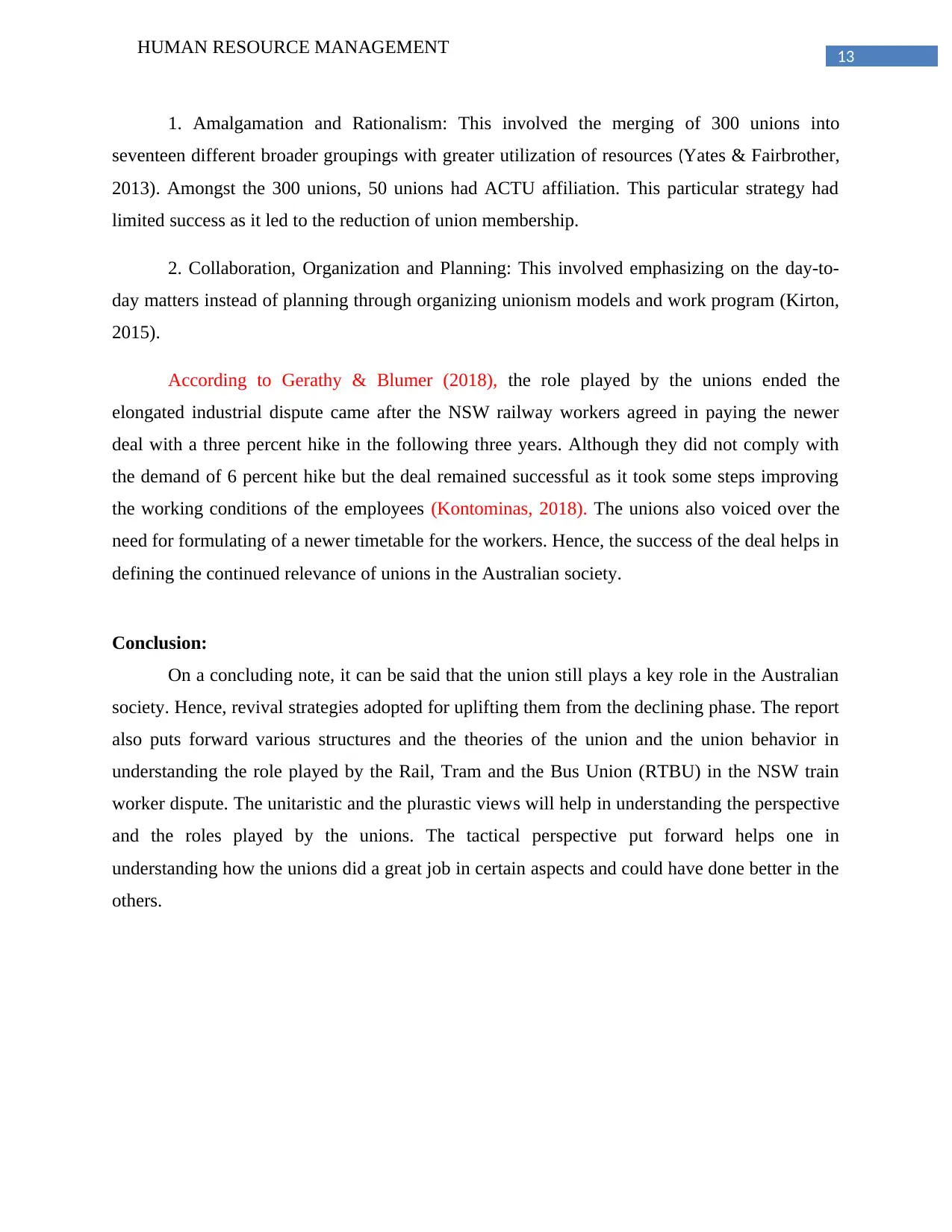
13
HUMAN RESOURCE MANAGEMENT
1. Amalgamation and Rationalism: This involved the merging of 300 unions into
seventeen different broader groupings with greater utilization of resources (Yates & Fairbrother,
2013). Amongst the 300 unions, 50 unions had ACTU affiliation. This particular strategy had
limited success as it led to the reduction of union membership.
2. Collaboration, Organization and Planning: This involved emphasizing on the day-to-
day matters instead of planning through organizing unionism models and work program (Kirton,
2015).
According to Gerathy & Blumer (2018), the role played by the unions ended the
elongated industrial dispute came after the NSW railway workers agreed in paying the newer
deal with a three percent hike in the following three years. Although they did not comply with
the demand of 6 percent hike but the deal remained successful as it took some steps improving
the working conditions of the employees (Kontominas, 2018). The unions also voiced over the
need for formulating of a newer timetable for the workers. Hence, the success of the deal helps in
defining the continued relevance of unions in the Australian society.
Conclusion:
On a concluding note, it can be said that the union still plays a key role in the Australian
society. Hence, revival strategies adopted for uplifting them from the declining phase. The report
also puts forward various structures and the theories of the union and the union behavior in
understanding the role played by the Rail, Tram and the Bus Union (RTBU) in the NSW train
worker dispute. The unitaristic and the plurastic views will help in understanding the perspective
and the roles played by the unions. The tactical perspective put forward helps one in
understanding how the unions did a great job in certain aspects and could have done better in the
others.
HUMAN RESOURCE MANAGEMENT
1. Amalgamation and Rationalism: This involved the merging of 300 unions into
seventeen different broader groupings with greater utilization of resources (Yates & Fairbrother,
2013). Amongst the 300 unions, 50 unions had ACTU affiliation. This particular strategy had
limited success as it led to the reduction of union membership.
2. Collaboration, Organization and Planning: This involved emphasizing on the day-to-
day matters instead of planning through organizing unionism models and work program (Kirton,
2015).
According to Gerathy & Blumer (2018), the role played by the unions ended the
elongated industrial dispute came after the NSW railway workers agreed in paying the newer
deal with a three percent hike in the following three years. Although they did not comply with
the demand of 6 percent hike but the deal remained successful as it took some steps improving
the working conditions of the employees (Kontominas, 2018). The unions also voiced over the
need for formulating of a newer timetable for the workers. Hence, the success of the deal helps in
defining the continued relevance of unions in the Australian society.
Conclusion:
On a concluding note, it can be said that the union still plays a key role in the Australian
society. Hence, revival strategies adopted for uplifting them from the declining phase. The report
also puts forward various structures and the theories of the union and the union behavior in
understanding the role played by the Rail, Tram and the Bus Union (RTBU) in the NSW train
worker dispute. The unitaristic and the plurastic views will help in understanding the perspective
and the roles played by the unions. The tactical perspective put forward helps one in
understanding how the unions did a great job in certain aspects and could have done better in the
others.
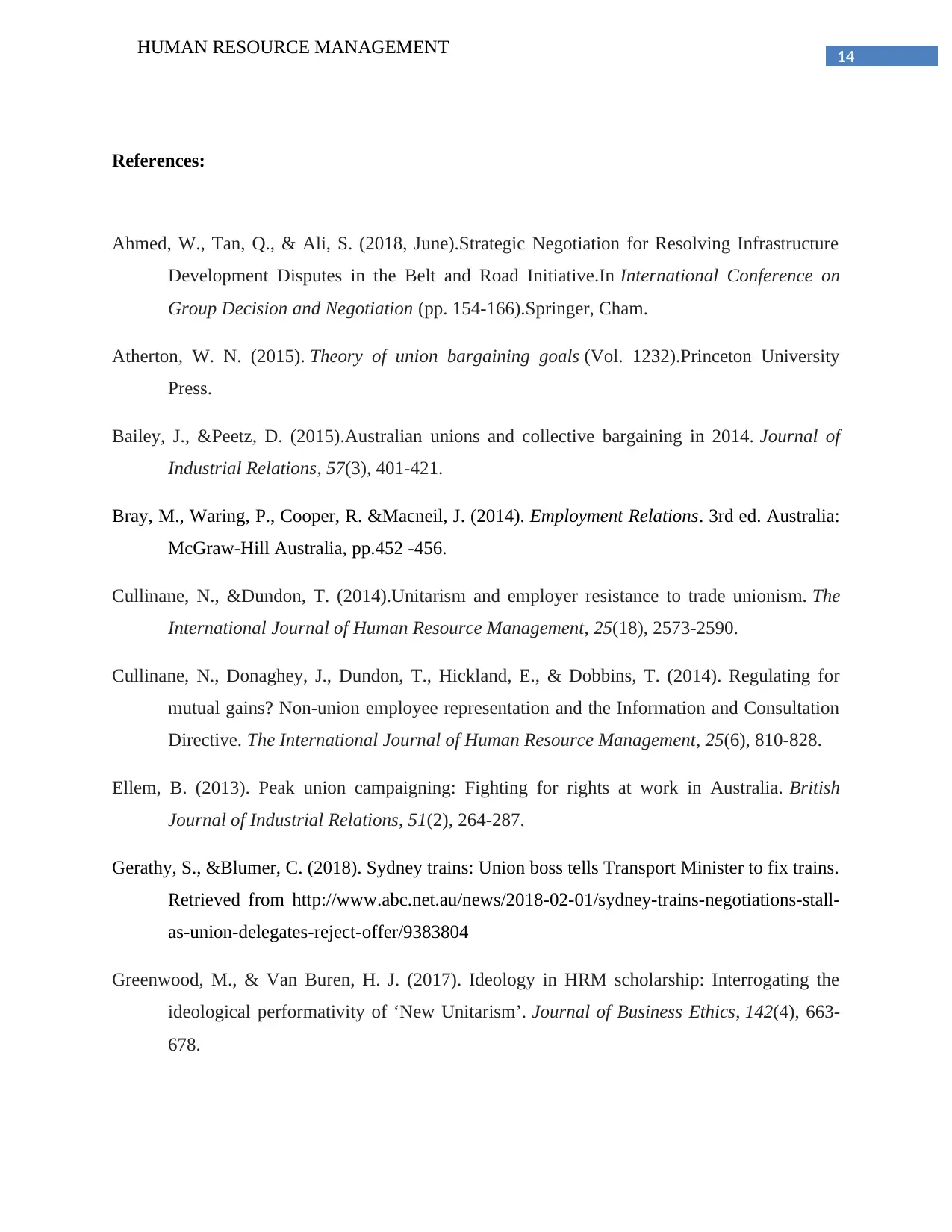
14
HUMAN RESOURCE MANAGEMENT
References:
Ahmed, W., Tan, Q., & Ali, S. (2018, June).Strategic Negotiation for Resolving Infrastructure
Development Disputes in the Belt and Road Initiative.In International Conference on
Group Decision and Negotiation (pp. 154-166).Springer, Cham.
Atherton, W. N. (2015). Theory of union bargaining goals (Vol. 1232).Princeton University
Press.
Bailey, J., &Peetz, D. (2015).Australian unions and collective bargaining in 2014. Journal of
Industrial Relations, 57(3), 401-421.
Bray, M., Waring, P., Cooper, R. &Macneil, J. (2014). Employment Relations. 3rd ed. Australia:
McGraw-Hill Australia, pp.452 -456.
Cullinane, N., &Dundon, T. (2014).Unitarism and employer resistance to trade unionism. The
International Journal of Human Resource Management, 25(18), 2573-2590.
Cullinane, N., Donaghey, J., Dundon, T., Hickland, E., & Dobbins, T. (2014). Regulating for
mutual gains? Non-union employee representation and the Information and Consultation
Directive. The International Journal of Human Resource Management, 25(6), 810-828.
Ellem, B. (2013). Peak union campaigning: Fighting for rights at work in Australia. British
Journal of Industrial Relations, 51(2), 264-287.
Gerathy, S., &Blumer, C. (2018). Sydney trains: Union boss tells Transport Minister to fix trains.
Retrieved from http://www.abc.net.au/news/2018-02-01/sydney-trains-negotiations-stall-
as-union-delegates-reject-offer/9383804
Greenwood, M., & Van Buren, H. J. (2017). Ideology in HRM scholarship: Interrogating the
ideological performativity of ‘New Unitarism’. Journal of Business Ethics, 142(4), 663-
678.
HUMAN RESOURCE MANAGEMENT
References:
Ahmed, W., Tan, Q., & Ali, S. (2018, June).Strategic Negotiation for Resolving Infrastructure
Development Disputes in the Belt and Road Initiative.In International Conference on
Group Decision and Negotiation (pp. 154-166).Springer, Cham.
Atherton, W. N. (2015). Theory of union bargaining goals (Vol. 1232).Princeton University
Press.
Bailey, J., &Peetz, D. (2015).Australian unions and collective bargaining in 2014. Journal of
Industrial Relations, 57(3), 401-421.
Bray, M., Waring, P., Cooper, R. &Macneil, J. (2014). Employment Relations. 3rd ed. Australia:
McGraw-Hill Australia, pp.452 -456.
Cullinane, N., &Dundon, T. (2014).Unitarism and employer resistance to trade unionism. The
International Journal of Human Resource Management, 25(18), 2573-2590.
Cullinane, N., Donaghey, J., Dundon, T., Hickland, E., & Dobbins, T. (2014). Regulating for
mutual gains? Non-union employee representation and the Information and Consultation
Directive. The International Journal of Human Resource Management, 25(6), 810-828.
Ellem, B. (2013). Peak union campaigning: Fighting for rights at work in Australia. British
Journal of Industrial Relations, 51(2), 264-287.
Gerathy, S., &Blumer, C. (2018). Sydney trains: Union boss tells Transport Minister to fix trains.
Retrieved from http://www.abc.net.au/news/2018-02-01/sydney-trains-negotiations-stall-
as-union-delegates-reject-offer/9383804
Greenwood, M., & Van Buren, H. J. (2017). Ideology in HRM scholarship: Interrogating the
ideological performativity of ‘New Unitarism’. Journal of Business Ethics, 142(4), 663-
678.
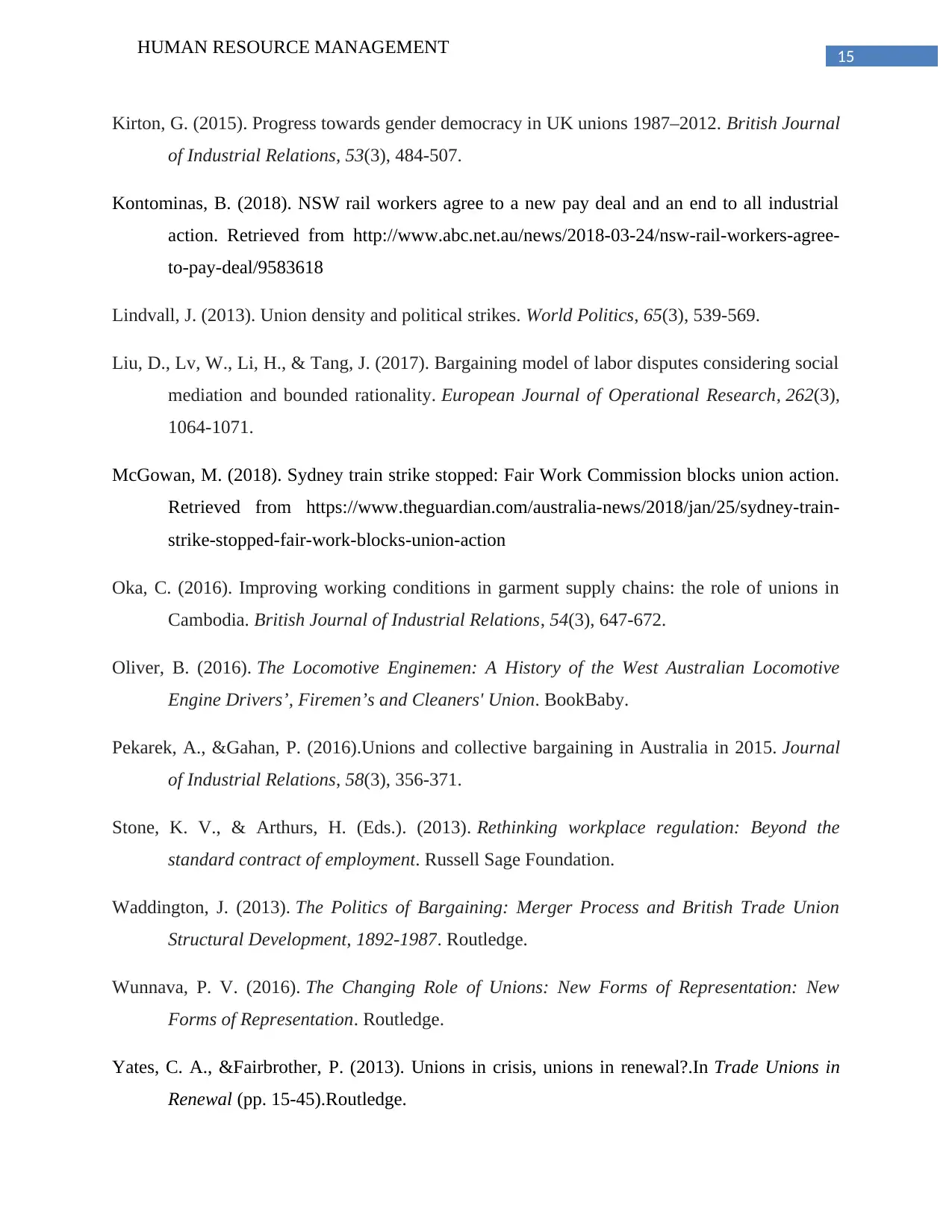
15
HUMAN RESOURCE MANAGEMENT
Kirton, G. (2015). Progress towards gender democracy in UK unions 1987–2012. British Journal
of Industrial Relations, 53(3), 484-507.
Kontominas, B. (2018). NSW rail workers agree to a new pay deal and an end to all industrial
action. Retrieved from http://www.abc.net.au/news/2018-03-24/nsw-rail-workers-agree-
to-pay-deal/9583618
Lindvall, J. (2013). Union density and political strikes. World Politics, 65(3), 539-569.
Liu, D., Lv, W., Li, H., & Tang, J. (2017). Bargaining model of labor disputes considering social
mediation and bounded rationality. European Journal of Operational Research, 262(3),
1064-1071.
McGowan, M. (2018). Sydney train strike stopped: Fair Work Commission blocks union action.
Retrieved from https://www.theguardian.com/australia-news/2018/jan/25/sydney-train-
strike-stopped-fair-work-blocks-union-action
Oka, C. (2016). Improving working conditions in garment supply chains: the role of unions in
Cambodia. British Journal of Industrial Relations, 54(3), 647-672.
Oliver, B. (2016). The Locomotive Enginemen: A History of the West Australian Locomotive
Engine Drivers’, Firemen’s and Cleaners' Union. BookBaby.
Pekarek, A., &Gahan, P. (2016).Unions and collective bargaining in Australia in 2015. Journal
of Industrial Relations, 58(3), 356-371.
Stone, K. V., & Arthurs, H. (Eds.). (2013). Rethinking workplace regulation: Beyond the
standard contract of employment. Russell Sage Foundation.
Waddington, J. (2013). The Politics of Bargaining: Merger Process and British Trade Union
Structural Development, 1892-1987. Routledge.
Wunnava, P. V. (2016). The Changing Role of Unions: New Forms of Representation: New
Forms of Representation. Routledge.
Yates, C. A., &Fairbrother, P. (2013). Unions in crisis, unions in renewal?.In Trade Unions in
Renewal (pp. 15-45).Routledge.
HUMAN RESOURCE MANAGEMENT
Kirton, G. (2015). Progress towards gender democracy in UK unions 1987–2012. British Journal
of Industrial Relations, 53(3), 484-507.
Kontominas, B. (2018). NSW rail workers agree to a new pay deal and an end to all industrial
action. Retrieved from http://www.abc.net.au/news/2018-03-24/nsw-rail-workers-agree-
to-pay-deal/9583618
Lindvall, J. (2013). Union density and political strikes. World Politics, 65(3), 539-569.
Liu, D., Lv, W., Li, H., & Tang, J. (2017). Bargaining model of labor disputes considering social
mediation and bounded rationality. European Journal of Operational Research, 262(3),
1064-1071.
McGowan, M. (2018). Sydney train strike stopped: Fair Work Commission blocks union action.
Retrieved from https://www.theguardian.com/australia-news/2018/jan/25/sydney-train-
strike-stopped-fair-work-blocks-union-action
Oka, C. (2016). Improving working conditions in garment supply chains: the role of unions in
Cambodia. British Journal of Industrial Relations, 54(3), 647-672.
Oliver, B. (2016). The Locomotive Enginemen: A History of the West Australian Locomotive
Engine Drivers’, Firemen’s and Cleaners' Union. BookBaby.
Pekarek, A., &Gahan, P. (2016).Unions and collective bargaining in Australia in 2015. Journal
of Industrial Relations, 58(3), 356-371.
Stone, K. V., & Arthurs, H. (Eds.). (2013). Rethinking workplace regulation: Beyond the
standard contract of employment. Russell Sage Foundation.
Waddington, J. (2013). The Politics of Bargaining: Merger Process and British Trade Union
Structural Development, 1892-1987. Routledge.
Wunnava, P. V. (2016). The Changing Role of Unions: New Forms of Representation: New
Forms of Representation. Routledge.
Yates, C. A., &Fairbrother, P. (2013). Unions in crisis, unions in renewal?.In Trade Unions in
Renewal (pp. 15-45).Routledge.
Paraphrase This Document
Need a fresh take? Get an instant paraphrase of this document with our AI Paraphraser

16
HUMAN RESOURCE MANAGEMENT
HUMAN RESOURCE MANAGEMENT
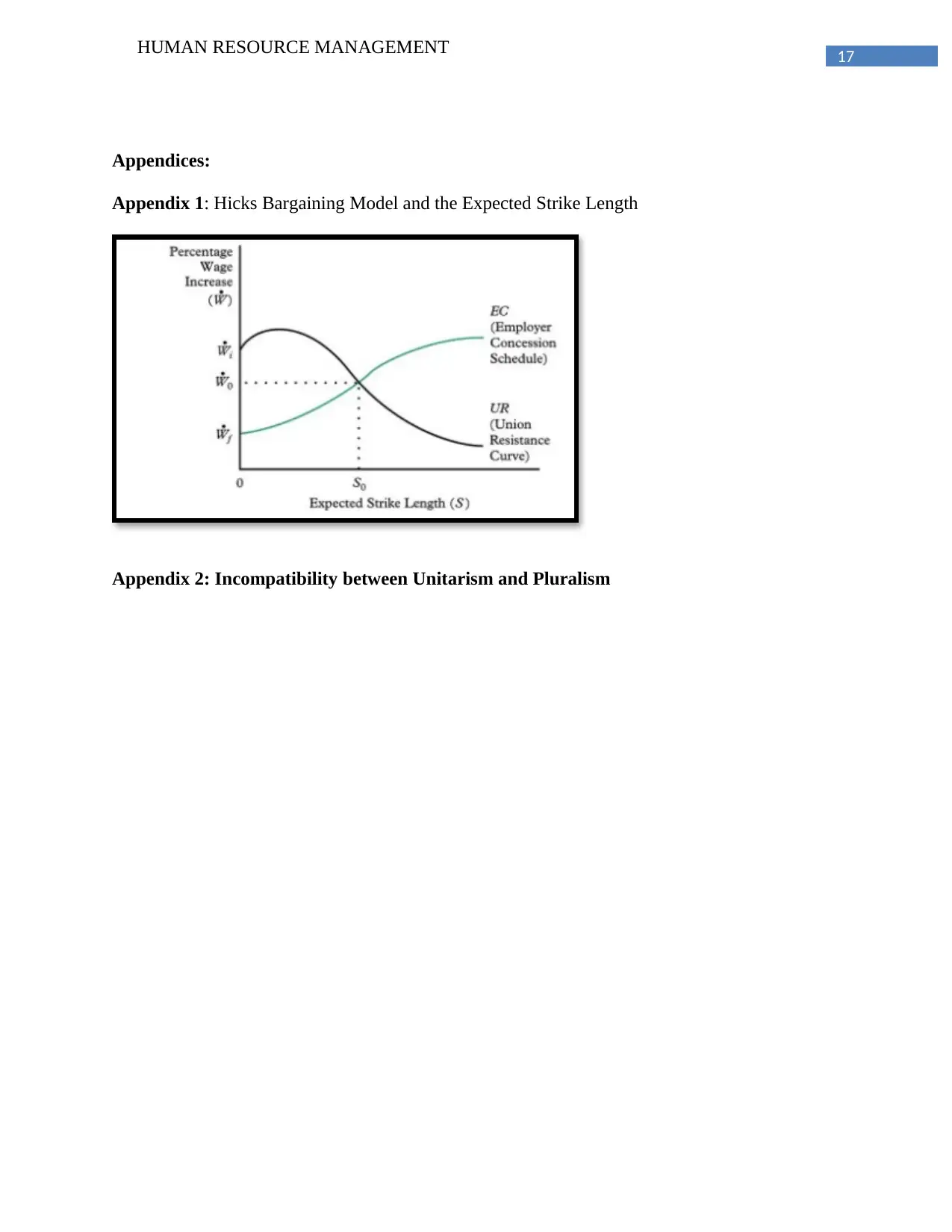
17
HUMAN RESOURCE MANAGEMENT
Appendices:
Appendix 1: Hicks Bargaining Model and the Expected Strike Length
Appendix 2: Incompatibility between Unitarism and Pluralism
HUMAN RESOURCE MANAGEMENT
Appendices:
Appendix 1: Hicks Bargaining Model and the Expected Strike Length
Appendix 2: Incompatibility between Unitarism and Pluralism
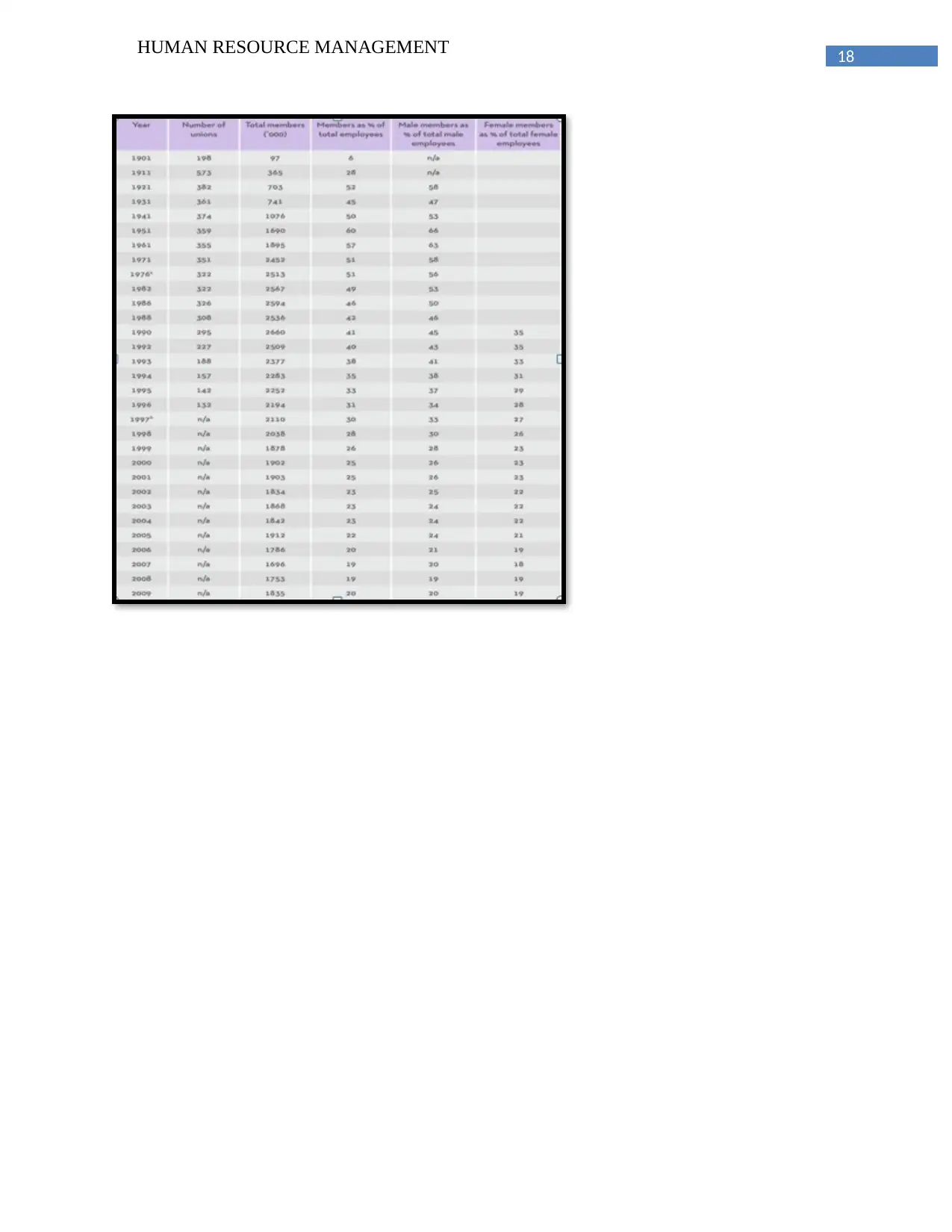
18
HUMAN RESOURCE MANAGEMENT
HUMAN RESOURCE MANAGEMENT
Secure Best Marks with AI Grader
Need help grading? Try our AI Grader for instant feedback on your assignments.

19
HUMAN RESOURCE MANAGEMENT
Appendix 3: Declining figures of Labor Union in Australian Society
HUMAN RESOURCE MANAGEMENT
Appendix 3: Declining figures of Labor Union in Australian Society
1 out of 20
Related Documents
Your All-in-One AI-Powered Toolkit for Academic Success.
+13062052269
info@desklib.com
Available 24*7 on WhatsApp / Email
![[object Object]](/_next/static/media/star-bottom.7253800d.svg)
Unlock your academic potential
© 2024 | Zucol Services PVT LTD | All rights reserved.




